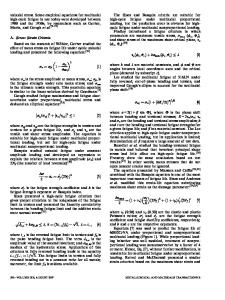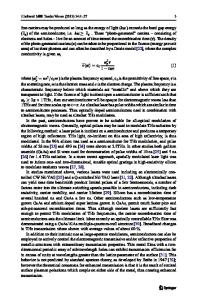Catastrophic Oxidation of Copper: A Brief Review
- PDF / 858,119 Bytes
- 9 Pages / 593.972 x 792 pts Page_size
- 15 Downloads / 369 Views
INTRODUCTION
COPPER may experience accelerated oxidation in the presence of low-melting oxides (MoO3, V2O5, Bi2O3, etc.) at elevated temperature in an oxidizing environment.[1,2] These oxides are frequently formed in various cooling devices (space technology and nuclear power engineering) where copper operates in contact with a refractory metal (Mo, V, W, etc.) and in copper metallurgy.[3] Accelerated oxidation of copper in the presence of low-melting oxides was observed first by Rathenau and Meijering[4,5] and is known as catastrophic oxidation. In catastrophic oxidation, copper is subject to degradation at much higher rates than in gaseous oxidation, with a porous nonprotective oxide scale, sulfides in the substrate, and hot corrosion.[6–28] Recently, both the fast and superfast stages of the catastrophic oxidation of copper are established and their mechanisms are developed.[29–35] The catastrophic oxidation can occur by diffusion or fluxing mechanisms. Realization of a particular mechanism depends on the mass ratio of the low-melting oxide to the metal. The diffusion mechanism is in effect under a thin, lowmelting oxide deposit. The fluxing mechanism predominates under a thick, low-melting oxide layer. The subject of catastrophic oxidation of copper is important for material science and industry. In material science, it is well known that the process of hightemperature oxidation of copper is described by a Wagner theory,[36] which establishes the relation among the parabolic rate constant, diffusion coefficient, and oxygen partial pressure. However, the rate of catastrophic oxidation of copper exceeds that predicted by V.V. BELOUSOV, Head of Laboratory, and A.A. KLIMASHIN, Junior Researcher, are with the A.A. Baikov Institute of Metallurgy and Materials, Russian Academy of Sciences, Moscow, Russia 119991. Contact e-mail: [email protected] Manuscript submitted September 23, 2011. METALLURGICAL AND MATERIALS TRANSACTIONS A
the Wagner theory by several orders of magnitude. In industry, copper is widely used as a heat conductor in different cooling devices.[3] In these applications, copper often operates in contact with a refractory metal or alloy based on it. However, some refractory metals and alloys are not compatible to the copper in an oxidizing environment at elevated temperature. In particular, catastrophic oxidation of copper takes place in contact with vanadium or molybdenum in air. The catastrophic oxidation is caused by forming V2O5 or MoO3 and liquid eutectic in the corrosion products.[1,2] Accelerated oxidation of copper stimulated by forming liquid corrosion products are intensively discussed in the literature.[31–35,37–39] The last decade has witnessed important advances in the theory and experiment of the accelerated oxidation of copper. Therefore, the purpose of this article is to review some of the fundamental knowledge now available to understand accelerated oxidation. To keep the article within limits, the reader is referred to the original publications for more details. II. ACCELERATED OXIDATION OF COP
Data Loading...











